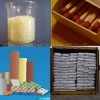- Vigna Beans[1]
- Kidney Beans[1]
- Chemical Auxiliary Agent[4]
- Other Organic Chemical[1]
- Adhesives & Sealants[1]
- Food Additives[1]
- Packaging Machinery[2]
- Printing Machinery[5]
- Animal Fur[4]
- Coats[2]
- Fur Scarves[1]
- Contact Person : Ms. Yang Sunny
- Company Name : Hebei Fucheng Import & Export Co.
- Tel : 86-318-8071519
- Fax : 86-318-5235766
- Address : Hebei,hengshui,EAST GATE OUT STREET, FUCHENG COUNTY
- Country/Region : China
- Zip : 053000
Industrial gelatin
Industrial Gelatin is light yellow or brown grain, which can pass the 4mm aperture standard sieve. It is mainly used in photographic paper, bill spread the nature, fixature, printing & dyeing, galvanoplastics liquid, polishing coating, emery cloth, sand paper, ink , rubber padding, leather polishing ,dyeing and weaving, paper making, handicraft glues, match ,wooden furniture, forage, rubber industry and construction field. Based on QB/T 1995-2005 national industry standards, we are equipped with great variety of goods and special glue used for different industries. We can handle SGS, ITS quality certificate and commercial inspection certificate and CIQ Veterinary (health) Certificate.
MANUFACTURING
Raw Materials
It is mainly used in photographic paper, bill spread the nature, fixature, printing & dyeing, galvanoplastics liquid, polishing coating, emery cloth, sand paper, ink , rubber padding, leather polishing ,dyeing and weaving, paper making, handicraft glues, match ,wooden furniture, forage, rubber industry and construction field. Based on QB/T 1995-2005 national industry standards, we are equipped with great variety of goods and special glue used for different industries. We can handle SGS, ITS quality certificate and commercial inspection certificate and CIQ Veterinary (health) Certificate.
First-class raw materials as a matter of course.
The optimum precautions to ensure safety and quality include the careful selection of the raw materials used to manufacture gelatine.
We use only raw materials from healthy pigs, cattle, fish and poultry that have been examined by a veterinarian. Furthermore, all GME member companies have been certified to ISO 9002 and have HACCP Standards in place. The gelatine manufacturing industry is one of the best structured and best controlled industries of all in Europe.
Approximately 80 per cent of the edible gelatine produced in Europe is pure pigskin gelatine. 15 per cent comes from cattle hide spit. This is the thin layer containing collagen between the upper skin and the subcutaneous layer. The remaining 5 per cent comes from pig and cattle bones, poultry and fish.
There are comprehensive European statutory regulations for the slaughter, the controls and the licensing procedure by governmental institutions. All raw materials are subject to continuous checks on safety and origin. The animals come only from approved slaughterhouses and are examined by veterinarians. Only raw materials from animals approved for human consumption are used for the manufacture of gelatine. Or in other words, the meat the consumer buys and the raw material for gelatine comes from one and the same healthy animal.
Production Process
Pre-treatment
First of all, the fat and minerals are removed from the raw materials. Afterwards two different pre-treatment methods are used, depending on the raw material and on the final application of the gelatine.
Alkaline procedureThe connective tissue of cattle is highly interconnected and is therefore pre-treated with lime in a process lasting several weeks. This brings about a gentle change to the collagen structure. After this treatment, the collagen is soluble in warm water and can thus be separated from the rest of the raw material.
Acid procedureThe collagen connective tissue from pigskin is not so heavily interconnected. Here, a one-day acid treatment with subsequent neutralization and the intensive rinsing out of the salts is sufficient to extract the collagen.
Extraction
The pre-treated raw materials are now treated with hot drinking water and extracted in several stages. The temperature of the hot water is a parameter for the jelly strength: the lower the temperature of the water, the higher the gel strength (bloom value) of the extracted gelatine.
Cleaning
The extracted solutions are freed of traces of fat and fine fibres in high-performance separators. Even the finest impurities are removed by filtration, in a similar way to the beverages industry. In a last purification stage the gelatine is freed of calcium, sodium, residual acid and other salts.
Thickening
The gelatine solution is now concentrated in vacuum evaporators and thickened to form a honey-like solution.
Drying
The highly concentrated gelatine solutions are sterilized, cooled, set and dried under strict hygienic conditions. In this process, “gel noodles” are formed that are ground into grains when dry.
The quality and purity of the gelatine is ensured by detailed quality control.
All of these steps are indispensable for gelatine manufacture and have been used for decades to manufacture high-quality gelatine.
Industrial gelatin




